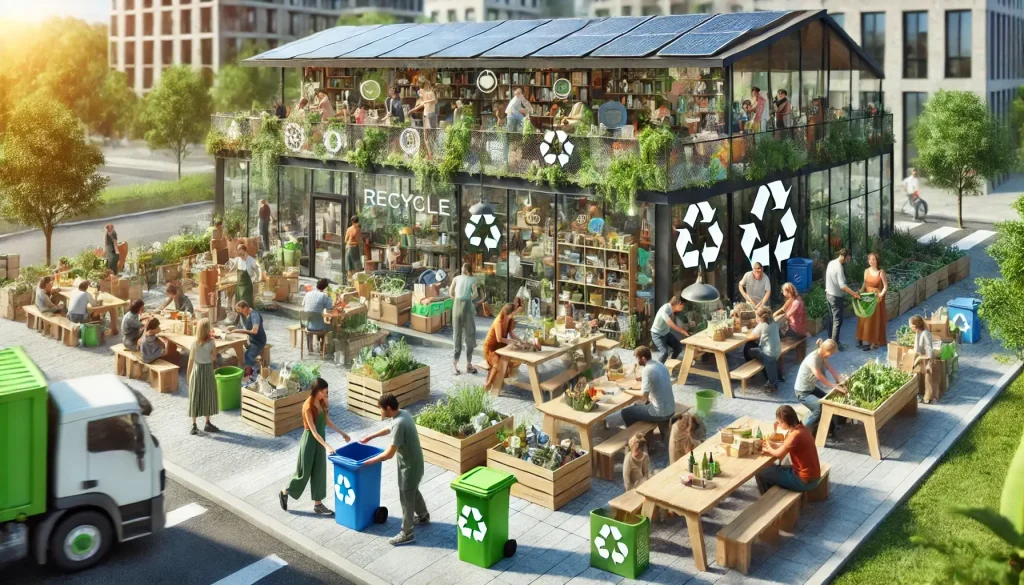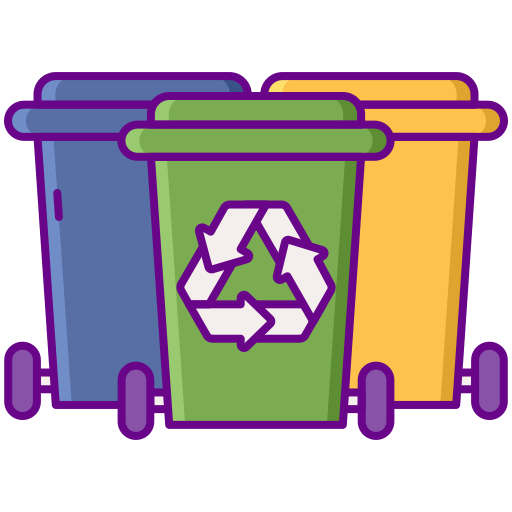In today’s era of environmental urgency and community engagement, the pursuit of sustainable living is essential for a resilient future. To thrive, communities must come together to adopt eco-friendly practices, and recycling is at the heart of this transformation. At Eu Setor, we believe that by integrating innovative recycling initiatives into everyday life, communities can thrive—creating healthier environments, reducing waste, and fostering social unity.

Index
The Vision for Thriving Eco-friendly Communities
Sustainable communities are built on the principle of living in harmony with nature while promoting economic, social, and environmental well-being. Recycling is more than a waste management solution; it’s a catalyst for community development. When communities thrive through recycling, they not only conserve natural resources but also create systems that support a circular economy, reduce pollution, and build lasting social bonds.
A New Paradigm for Community Sustainability
The idea to thrive in an eco-friendly community is rooted in the integration of recycling practices at every level—from individual households to large urban centers. This holistic approach includes:
- Reducing Waste: Minimizing waste through efficient recycling practices helps conserve natural resources and reduces landfill usage.
- Economic Empowerment: Recycling creates jobs and supports local businesses, leading to economic growth that benefits the entire community.
- Social Cohesion: Community-driven recycling initiatives encourage collaboration, education, and shared responsibility, fostering a strong sense of unity and pride.
By embracing recycling as a core value, communities can thrive in a way that respects the environment and promotes long-term sustainability.
Key Strategies for Building Eco-friendly Communities
Building communities that truly thrive requires a multifaceted approach. Below are several strategies that are essential for creating eco-friendly environments through recycling.
1. Community Recycling Programs
Effective recycling begins at the community level. Establishing accessible recycling programs is crucial for reducing waste and promoting sustainability.
- Local Collection Centers: Setting up neighborhood recycling hubs makes it easier for residents to dispose of recyclables properly. These centers can serve as focal points for education and community engagement.
- Smart Recycling Bins: Equipping bins with sensors and digital displays encourages proper recycling habits. These smart bins monitor waste levels in real time and alert community managers when collection is needed, ensuring maximum participation.
- Public Outreach: Regular workshops, seminars, and community events educate residents about the benefits of recycling and how it contributes to a sustainable future. These initiatives inspire individuals to take ownership of their environmental impact, helping the community thrive.
2. Partnerships with Local Businesses
Local businesses play a critical role in building sustainable communities. By partnering with recycling initiatives, businesses can reduce their environmental footprint and contribute to the local economy.
- Corporate Social Responsibility: Companies can adopt recycling programs as part of their sustainability efforts, helping to thrive while also setting industry standards for eco-friendly practices.
- Incentive Programs: Businesses can offer discounts or rewards to customers who recycle, creating a win-win scenario that boosts recycling rates and encourages responsible consumption.
- Green Supply Chains: Collaborating with local recycling facilities and using recycled materials in production processes not only supports environmental sustainability but also stimulates local economic growth.
3. Educational and Awareness Campaigns
Education is the cornerstone of any successful recycling initiative. Empowering communities with knowledge about sustainable practices is key to creating lasting change.
- School Programs: Integrating recycling education into school curriculums instills eco-friendly habits in young minds, ensuring that future generations understand the importance of sustainability.
- Public Information Campaigns: Utilizing social media, local media, and community newsletters to share recycling tips, success stories, and environmental benefits raises awareness and motivates action.
- Interactive Platforms: Digital apps and websites can provide real-time information on recycling guidelines, collection schedules, and community achievements, keeping residents informed and engaged.
4. Technological Integration
Advancements in technology are enhancing the efficiency and effectiveness of recycling initiatives, making it easier for communities to thrive sustainably.
- IoT and Smart Sensors: The use of IoT devices in recycling infrastructure allows for real-time monitoring of waste, optimizing collection routes, and reducing operational costs.
- Data Analytics: Analyzing recycling data helps communities identify areas for improvement, track progress, and set measurable sustainability goals.
- Digital Engagement: Mobile apps that reward eco-friendly behaviors and provide recycling tips foster a culture of sustainability and encourage higher participation rates.
5. Policy Support and Incentives
Government policies and regulations can significantly influence recycling practices and help communities thrive environmentally.
- Recycling Mandates: Implementing laws that require recycling and the use of recycled materials in manufacturing creates a framework for sustainable practices.
- Financial Incentives: Tax breaks, subsidies, and grants for businesses and communities that invest in recycling technology can accelerate the adoption of eco-friendly practices.
- Collaboration Initiatives: Public-private partnerships that focus on environmental sustainability help streamline efforts and provide the necessary funding and expertise to support large-scale recycling programs.
Environmental, Economic, and Social Impacts
Recycling initiatives that empower communities to thrive deliver benefits that span across multiple dimensions.
Environmental Benefits
- Waste Reduction: Efficient recycling reduces the amount of waste that ends up in landfills, lowering soil and water pollution.
- Resource Conservation: Recycling conserves natural resources by reducing the need for raw material extraction, thus protecting ecosystems and biodiversity.
- Energy Savings: Recycled materials typically require less energy to process compared to new products, leading to lower greenhouse gas emissions and a smaller carbon footprint.
Economic Advantages
- Job Creation: The recycling sector generates employment opportunities in waste collection, processing, and remanufacturing, bolstering local economies.
- Cost Reduction: Utilizing recycled materials often reduces production costs, making sustainable products more affordable for consumers.
- Market Growth: Companies that invest in green recycling practices gain a competitive edge by appealing to eco-conscious consumers, driving market innovation and economic growth.
Social Impacts
- Community Cohesion: Recycling initiatives encourage collective action, building stronger community ties and fostering a sense of shared purpose.
- Improved Quality of Life: Reduced pollution and better waste management lead to healthier living environments, enhancing overall public health.
- Educational Value: Recycling programs provide opportunities for learning and skill development, equipping community members with the knowledge to contribute to sustainable practices.
Case Studies: Communities That Thrive
Real-world examples demonstrate how communities can thrive by embracing recycling initiatives.
Case Study 1: Urban Recycling Success
A major city implemented a comprehensive recycling program that included smart recycling bins, public awareness campaigns, and digital engagement tools. This initiative led to a 40% increase in recycling participation, a significant reduction in landfill waste, and improved urban air quality. The project not only enhanced the environmental health of the city but also fostered community pride and collaboration.
Case Study 2: Green Business Partnerships
A cluster of local businesses in a suburban area partnered with recycling centers to integrate recycled materials into their production processes. Through cost savings, enhanced corporate image, and increased consumer loyalty, these businesses created a model for sustainable economic development. Their efforts led to a measurable increase in local recycling rates and spurred further investments in eco-friendly technologies, allowing the entire community to thrive.
Case Study 3: Community Recycling Hub
In a small town, a community-driven recycling hub was established, providing accessible drop-off points, educational workshops, and incentive programs. The hub served as a catalyst for change, significantly boosting local recycling rates and reducing waste. Residents reported a stronger sense of community, and local schools began incorporating recycling education into their curricula. This grassroots initiative demonstrated that when communities work together, they can truly thrive through sustainable practices.
Future Directions: Empowering Communities to Thrive
As we look toward the future, continued innovation and collaboration will be key to helping communities thrive through recycling. Emerging trends and technologies promise to further enhance resource conservation and sustainability.
Advancements in Technology
- Next-Generation IoT and AI: Future developments in IoT and AI will allow for even more precise monitoring and optimization of recycling operations, ensuring that communities can efficiently manage waste and conserve resources.
- Digital Transformation: Enhanced digital platforms will provide real-time tracking, transparent reporting, and more engaging ways to involve citizens in recycling efforts, creating a strong foundation for sustainable community practices.
Strengthening Community Engagement
- Local Initiatives: Expanding community recycling hubs and education programs will continue to empower residents to take an active role in sustainable practices.
- Public-Private Partnerships: Collaborative efforts between government agencies, businesses, and community organizations will drive policy changes and provide the necessary resources to support eco-friendly initiatives.
- Global Exchange: International collaboration and the sharing of best practices will help communities around the world thrive by adopting proven recycling strategies and technologies.
Policy Evolution and Consumer Empowerment
- Regulatory Support: Stronger policies and incentives for recycling will further embed sustainable practices into everyday life, ensuring that communities have the support they need to thrive.
- Consumer Awareness: As more people become aware of the benefits of recycling, demand for eco-friendly products will grow, driving innovation and market transformation that benefits both the environment and society.
Conclusion: Thrive Through Recycling
Building eco-friendly communities through recycling is a powerful strategy to thrive sustainably. By embracing innovative technologies, fostering community engagement, and integrating recycling into the fabric of everyday life, we can transform waste into valuable resources and create a future where communities flourish.
At Eu Setor, we are passionate about helping communities thrive by pioneering green practices and sustainable recycling initiatives. We invite you to join us on this transformative journey—explore advanced recycling strategies, get involved in local programs, and contribute to a greener, more resilient future for all.
For more insights, detailed guides, and inspiration on building eco-friendly communities through recycling, please visit our website at eu.setorreciclagem.com.br and become part of the Eu Setor community. Together, we can thrive by transforming our environment, one recycled material at a time.
